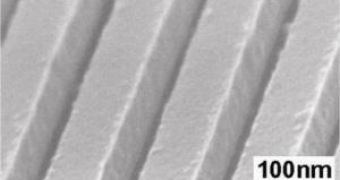The size and efficiency of future devices relying on laser optics (like DVD players, computer circuits and laser printers) could be highly improved by a novel high-performance mirror developed by a team at University of California, Berkeley.
This mirror has the same 99.9 % reflective punch as high-grade mirrors, named distributed Bragg reflectors (DBRs), but it is at least 20 times thinner, functional in a considerably larger spectrum of light frequencies, and easier to manufacture, critical advantages for the ever smaller integrated optical devices.
"Today's semiconductor lasers demand mirrors that can deliver high reflectivity, but without the extra thickness," said Connie J. Chang-Hasnain, a UCB professor of electrical engineering and computer science and director of the Center for Optoelectronic Nanostructured Semiconductor Technologies.
"When you reduce the thickness of a mirror, you are significantly reducing the mass of the device, which also translates into lower power consumption. The mirror we've developed overcomes the hurdles that have stalled the advancement of certain lasers."
The coherent, single laser beam is achieved by a pair of mirrors at opposite ends of a photon-generating gain medium: photons of a specific frequency bounce back and forth between the mirrors, accumulating energy into a laser beam.
Previous semiconductor lasers employed crystal mirrors, with a mere 30 % reflection, which is too inefficient for vertical-cavity surface-emitting lasers (VCSEL), employed in short-range optical communications, optical mice for computers and other devices with low power consumption.
VCSELs have a particularly short gain medium, so a highly reflective mirror is necessary, using DBRs.
In these reflectors, photons move through alternating layers of aluminum gallium arsenide, with a refractive index of 3.0, and gallium arsenide, with a refractive index of 3.6, and the variation in refractive indices makes a small light amount to be reflected from each pair of alternating layers, gathered in a powerful coherent beam. "DBRs can reflect 99.9 % of light, but it can take up to 80 layers of material to achieve this high reflectivity. The DBR ends up being a relatively thick 5 micrometers wide. The precision necessary for the layers also requires a complicated manufacturing process. Our mirror is thinner and will be easier to manufacture, which keeps the cost low."
The new mirror contains only one pair of alternating refractive-index layers, instead of many, by aluminum gallium arsenide with a layer of air, which has an extremely low refractive index (1). The aluminum gallium arsenide contained grooves spaced by a distance less than a light wavelength and light reaching the mirror surface was headed over the grooves.
Light waves moving each semiconductor-air interface were strongly reflected back in the opposite direction.
The researchers noted that other materials could replace air as the low refractive index material.
The team replaced one of the two DBRs in a vertical-cavity surface-emitting laser with the new mirror and showed that HCG could provide reflectivity greater than 99.9 % (the value for the DBR). "The HCG mirror overcomes many of the hurdles that had slowed the advance of VCSEL research. In addition to being thinner, it has the advantage of working in a broader range of light frequencies", said Ye Zhou, one of the researchers. This is extremely valuable for optical disc technologies which apply more and more blue-violet lasers, working in a shorter wavelength than red lasers.
Mobile HCG mirror could be implemented in micro-electromechanical systems (MEMS), like wavelength tunable lasers, employed in broadband communications. "Reducing the size of the laser's mirror also means a dramatic reduction in weight, which is particularly important for high-speed MEMS devices," said Chang-Hasnain.
This mirror could be printed in various surfaces to create organic, plastic displays that can be rolled up for easy transport. "There is a wide range of products based upon laser optics that could benefit with this thinner mirror. They include light emitting diodes, photovoltaic devices, sensors, computer chips and telecommunications equipment", said Huang.

 14 DAY TRIAL //
14 DAY TRIAL //